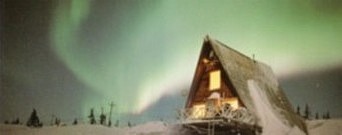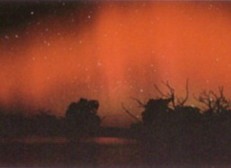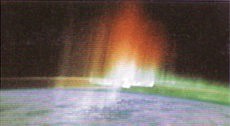
THE AIRLINE PILOTS FORUM & RESOURCE
Aurora |
| Source: Excerpt from The Book " Weather " |
 |

One of nature's most stunning displays is the aurora, with its silently shifting curtains of luminous color
often covering much of the night sky. Sometimes, it will appear as a colorful, glowing arc, remaining virtually stationary for extended periods. At other times, it will
appear to glide eerily about the sky in a flowing waterfall of color.
Auroras occur in both hemispheres, and are known as either the aurora borealis (northern lights) [as shown in the picture above] or the aurora australis (southern lights) [as hown in the picture on the right, whereas the picture below is of aurora australis viewed from the space shuttle Discovery]. The word aurora is derived from the name of the Roman goddess of the dawn,
and references to auroras exist in the writings of
the ancient Greeks and Romans and appear in the Bible. In medieval Europe, the northern lights were regarded with fear and superstition as omens of approaching disaster. Not surprisingly, the folklore of peoples of high northern latitudes, such as the Inuit, is rich in references to the aurora borealis. Similarly, the aurora australis occupies a prominent place in the mythology of the New
Zealand Maoris as the "burning of the sky".
As with all optical phenomena, science has provided an explanation for auroras. We now know that they are caused when incoming electrons from solar emissions encounter gas molecules in the Earth's upper atmosphere, between 50 and 600 miles (80 to 1,000 km) above the surface. Traveling at roughly 1,000 miles (1,600 km) per second, these electrons collide with oxygen and nitrogen molecules in the atmosphere, producing an electronic "splash" of light, known as a quantum. The wavelength, and therefore the visible appearance of this light, depends on which molecule takes the impact of the electron, and the air pressure at which the collision occurs. When electrons collide with oxygen molecules in low-pressure areas of the atmosphere, a yellow-green aurora occurs. Red is produced by collisions with oxygen in areas of even lower pressure at higher altitudes. A blue tinge is produced by interaction with atmospheric nitrogen. AURORAL ZONES Electrons have a negative charge and are directed north and south by the Earth's magnetic field towards the two magnetic poles. This is why auroras are primarily a high-latitude phenomenon, occurring within two "Auroral Zones", which lie about 20 to 25 degrees from the Earth's north and south magnetic poles. Seen from space, an aurora appears as a giant ring of glowing particles, centered on a magnetic pole. Within the auroral zones, auroras are visible on most clear nights at any time of the year. They appear most frequently around the times of the equinoxes, for reasons that are not clear. What is better understood is the connection between auroras and sunspots. As auroras are caused by solar emissions, it is not surprising that they occur most often during the 11-year maximum in sunspot activity, and only rarely during the time of minimum sunspots. During periods of maximum activity, the northern lights have been seen as far south as Athens and Mexico City, and the southern lights as far north as Brisbane in Australia. Attempts have been made over the years to confirm a link between intense solar activity and unusually cold or warm weather. Although tantalizing, such links have yet to be proved. |
Acknowledgement: John W. Zillman, William J. Burroughs,
Bob Crowder, Ted Robertson, Eleanor Vallier-Talbot and Richard Whitaker.


